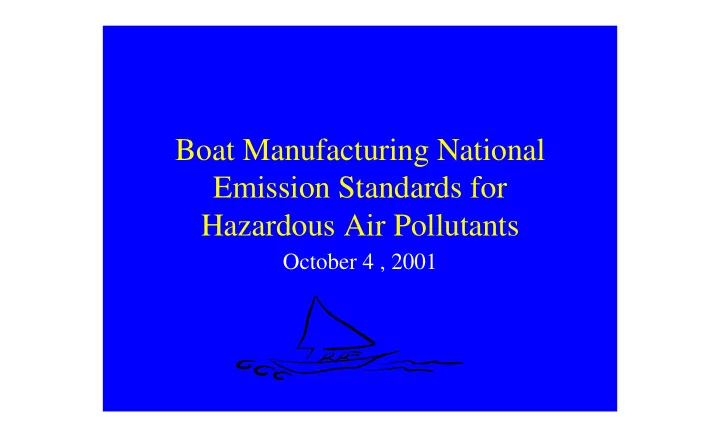

Boat Manufacturing National Emission Standards for Hazardous Air Pollutants October 4 , 2001
General Information • Proposed on July 14, 2000 (65 FR 43842) • Final rule signed by Administrator on 8/14/2001. • Can be found on Federal Register website at http://www.access.gpo.gov/nara/ or at http://www.epa.gov/ttn/caaa/t3pfpr.html • For information on applicability and rule determinations, contact the appropriate State or local agency representative • For other information, contact Mark Morris at (919) 541-5416 or morris.mark@epa.gov
The Boat Rule Applies if: • You manufacture hulls or decks of boats from fiberglass or aluminum, or assemble boats from premanufactured hulls and decks, or build molds to make fiberglass hulls or decks • You have the potential to emit 10 tons per year of one hazardous air pollutant (HAP) or 25 tons per year of a combination of HAP (i.e., you are a "major source")
What Parts of a Boat Facility Are Covered? • Open molding resin and gel coat operations (including pigmented gel coat, clear gel coat, production resin, tooling gel coat, and tooling resin) • Closed molding resin operations • Resin and gel coat mixing and application equipment cleaning operations • Carpet and fabric adhesive operations • Aluminum hull and deck coating operations
What Parts of a Boat Facility Are Not Covered? • Aluminum coating operations on aluminum boats intended for nonrecreational use • Antifoulant coatings • Assembly adhesives • Fiberglass hull and deck coatings • Research and development activities • Mold sealing and release agents • Mold stripping and cleaning solvents • Wood coatings
Compliance Dates • For existing sources: Approximately 9/2004 • For new sources: Upon startup
Standard for Open Molding Operations Allowable HAP = 46(M R ) + 159(M PG ) + 291(M CG ) +54(M TR ) + 214(M TG ) Where the numbers (46, 159, etc.) are "point values," M is mass of material, and the subscripts are: R - Production Resin PG- Pigmented Gelcoat CG- Clear Gelcoat TR- Tooling Resin TG- Tooling Gelcoat
Open Molding Compliance Options • Compliant materials – may average over rolling 12-month period • Emissions averaging – using point values • Add-on control device
Compliant Materials Operation Application Method Organic HAP Content (weight %) Production Resin Atomized 28 Nonatomized 35 Pigmented Gelcoat Any Method 33 Clear Gelcoat Any Method 48 Tooling Resin Atomized 30 Nonatomized 39 Tooling Gelcoat Any Method 40
Compliant Materials • If you always use materials meeting the limits in the table above, you only need to keep track of HAP content and application method • If you use materials of varying HAP content, you would show compliance on a 12-month rolling average – You need to keep track of HAP content, application method, mass of material used, and perform the rolling average calculations
Emissions Averaging • If you can’t meet a limit in the table above for a material, then you can compensate for that by going below the limit(s) for other material(s) • Use point values – Point values are a way to compare the emissions of different materials and different application methods – Plug in organic HAP content into a formula to get a point value – Point values have units of mass of HAP per mass of resin or gelcoat (kilogram HAP/megagram material)
Emissions Averaging • Point value example: – Production resin with 35% organic HAP applied with a flowcoater – Point value equation for this scenario is: 0.014 x (HAP%) 2.275 – So, 0.014 x (35) 2.275 = 46
Emissions Averaging "Actual" HAP = (PV R )(M R ) + (PV PG )(M PG ) + (PV CG )(M CG ) + (PV TR )(M TR ) + (PV TG )(M TG ) Where the point values are calculated as above, M is mass of material, and the subscripts are: R - Production Resin PG- Pigmented Gelcoat CG- Clear Gelcoat TR- Tooling Resin TG- Tooling Gelcoat
Other Fiberglass Provisions • Closed molding: no further reductions required • Mixing containers (larger than 55 gallons) have to be covered • Application equipment cleaning solvents must have less than 5% organic HAP • Carpet and fabric adhesives must have less than 5% organic HAP
Aluminum Coating Operations • Emission limits: – Wipedown solvents: 0.33 kilograms of organic HAP per liter of total coating solids applied – Coatings: 1.22 kilograms of organic HAP per liter of total coating solids applied – Can also meet a combined limit of 1.55 kg/l instead of the individual limits above
Aluminum Boat Operations: Other Provisions • Spray gun cleaning work practices • Carpet and fabric adhesives must have less than 5% organic HAP
Changes Since Proposal • Research and development operations not covered • Exemption for 100% vinylester skincoats – Still have to be applied with nonatomized technology – No more than 5% of total resin usage • 12-month rolling average instead of 3- month rolling average
Recommend
More recommend